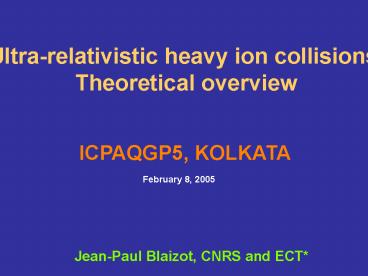Prsentation PowerPoint - PowerPoint PPT Presentation
1 / 38
Title:
Prsentation PowerPoint
Description:
Ultra-relativistic heavy ion collisions. Theoretical overview. ICPAQGP5, KOLKATA. February 8, 2005. Jean-Paul Blaizot, CNRS and ECT* Ultra-relativistic heavy ion ... – PowerPoint PPT presentation
Number of Views:22
Avg rating:3.0/5.0
Title: Prsentation PowerPoint
1
Ultra-relativistic heavy ion collisions
Theoretical overview
ICPAQGP5, KOLKATA February 8, 2005
Jean-Paul Blaizot, CNRS and ECT
2
Ultra-relativistic heavy ion collisions
- Explore properties of matter under extreme
conditons (density, temperature) - Study how QCD works in unusual conditions
- Much focus on formation of quark-gluon plasma
3
Fundamental questions
- What is the form of matter at extreme
temperature or density? - What is the wave function of a hadron, a nucleus,
at asymptotically high energy?
SIMPLICITY emerges in extreme (asymptotic)
situations
4
At high temperature and/or high
density matter is simple
5
QCD Interactions Weaken at High Energy
(S. Bethke, hep-ex/0211012)
6
The quark-gluon plasma
Energy density
Free gas limit
Temperature
(from F. Karsch, hep-lat/0106019)
7
Weak coupling calculations provide adequate
description Of the thermodynamics at high
temperature
Dimensional reduction
Weakly interacting quasiparticles
SU(3) Pressure
(from F. Karsch, hep-lat/0106019)
(from F. Kajantie et al, PRL86, PRD67)
8
The QCD phase diagram
T
Quark-Gluon Plasma
Hadronic matter
?B
Nuclei
9
Theory near Tc is difficult
Degrees of freedom? Strong coupling? Bound
states?
and present experiments may be Probing this
region
10
Simple quasiparticle picture breaks down close
to Tc
Speed of sounds decreases as one approaches Tc
from above
(from F. Csikor et al, hep-lat/0401022)
(from R. Gavai and S. Gupta)
11
How does the wavefunction of a nucleus look like
at asymptotically high energy ?
12
High density partonic systems
Parton density grows as x decreases
13
The very early stages of nucleus-nucleus
collisions
Physics of dense systems of quarks and gluons
Weak coupling but many active degrees of freedom
Non linear QCD effects become important when
14
Gluon saturation
(Gribov, Levin, Ryskin 83)
Large gluon densites at small x
Non linear effects important when
i.e. at a characterisitic scale
Saturation scale
(saturated regime)
(dilute regime)
15
The saturation scale
From fit to DIS (HERA)
In a nucleus
The densities in the central rapidity of a
nucleus-nucleus collision at RHIC are similar
to those at HERA.
At the LHC
At RHIC, smaller x can be reached in the forward
rapidity region
16
Early stages of a nucleus-nucleus collision
Partons set free have typical tranverse momenta
They are set free at (proper) time
At that time
Phenomenology based on such arguments (refined)
is reasonably successful at RHIC
17
High density partonic systems
Large occupation numbers
Classical fields
McLerran-Venugopalan, etc.
Non linear evolution equations
Balitsky-Kovchegov equation
COLOR GLASS CONDENSATE and JIMWLK() equation
() Jalilian-Marian, Iancu, McLerran, Weigert,
Leonidov, Kovner
18
Experimental discoveries at RHIC
Large energy density achieved
Collective behaviour observed
Jet quenching and strong final state
interactions
Hints of gluon saturation
And much more
(Focus on observables sensitive to initial state)
19
Large energy density
20
Moderate increase of multiplicity with beam energy
From Phenix White paper
21
Bjorken energy density
22
Elliptic flow
23
Produced particles flow preferentially in the
reaction plane
(J.-Y. Ollitrault, 1992)
(P.F. Kolb, J. Sollfrank and U. Heinz, PRC 62
(2000) 054909)
(S. Voloshin and Y. Zhang, 1994)
24
Elliptic flow
(Phenix white paper)
25
Comparison with hydrodynamics
(From U. Heinz, nucl-th/0412094)
26
- Strong conclusions drawn from comparison
- with hydrodynamical calculations
- early thermalisation time
- sensitivity to equation of state
- - low viscosity
27
Some simple remarks ()
Euler equation
Speed of sound
For constant speed of sound
The overall energy density scale is irrelevant
for collective flow
( R. Bhalerao, J-P B, N. Borghini, J.-Y.
Ollitrault)
28
For constant speed of sound
(ellipticity)
The time scale for establishing elliptic flow is
Argument for early thermalisation based on
delayed hydro expansion. Natural time scale is
large
Small thermalisation time unatural (?)
29
Good control parameter ? -initial energy
density (no) -average number of collisions
during the build up of elliptic flow (?)
(From NA49, nucl-ex/0303001)
30
Jet quenching and strong final state
interactions
31
Jet production in matter
Au-Au nucl-ex/0304022
32
Control experiment d-AU
(PHENIX, nucl-ex/0401001)
33
STAR Phys.Rev.Lett.91072304,2003
34
Hints of gluon saturation
35
Suppression can also be due to initial state
effects (nuclear wave function probed at small x
color glass condensate)
y 0 0.05 0.1 0.2 0.4 0.6 1 1.4 2
Solution of the BK equation, Albacete et al,
hep-ph/0307179
(Related analytical work by Iancu, Itakura,
Triantafyllopoulos hep-ph/0403103)
36
(No Transcript)
37
(Kharzeev, Kovchegov, Tuchin, hep-ph/0405045)
38
SUMMARY
- -Strongly interacting matter is produced in high
energy nucleus-nucleus collisions. Large
initial energy density. Collective behaviour. - Many (indirect) evidences that partonic degrees
of freedom play an important role in the
collision dynamics at RHIC - Early stages of the collisions, and hence
initial state effects are important at RHIC
(and will be more so at LHC). - Hints of saturation (color glass condensate) may
be already present at RHIC. Phenomenology based
on saturation ideas is reasonably successful at
RHIC - QCD has become a central reference in the
analysis of the data































